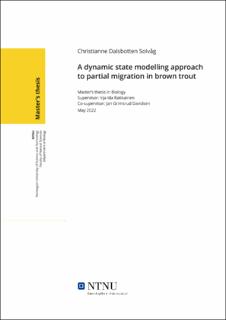| dc.contributor.advisor | Ratikainen, Irja Ida | |
| dc.contributor.advisor | Davidsen, Jan Grimsrud | |
| dc.contributor.author | Solvåg, Christianne Dalsbotten | |
| dc.date.accessioned | 2022-07-09T17:22:27Z | |
| dc.date.available | 2022-07-09T17:22:27Z | |
| dc.date.issued | 2022 | |
| dc.identifier | no.ntnu:inspera:104135638:23579368 | |
| dc.identifier.uri | https://hdl.handle.net/11250/3004407 | |
| dc.description.abstract | Partiell migrasjon, fenomenet der ein populasjon har både individ som migrerer og individ som let vere, er observert i store delar av dyreriket. Mekanismane bak kan vere komplekse, og kan inkludere både genetikk og miljø som medverkande faktorar. Tidlegare studiar har funne at andelen som migrerer i populasjonar av (Salmo trutta) varierer utifrå miljøet, medan skilnadar innad ein populasjon er i stor grad kontrollert av den kroppslege tilstanden til individa. Det er dertimot motstridande funn om kva for trekk som har størst påverknad og i kva retning dei påverkar individa i valet om å migrere eller bli verande. I denne masteroppgåva hadde eg som mål å kaste lys over rolla som kroppsleg tilstand spelar i migrasjonsåtferden til aure, og korleis det i samspel med miljøforhold skapar ulike tendensar til å migrere. Eg har nytta ein dynamisk tilstandbasert modell ("dynamic state model") for å undersøke korleis kroppsmasse, kroppslengde og kroppskondisjon påverkar kva som er dei optimale smoltifiserings- og migrasjonsavgjerdene ein umoden hofisk kan ta i laupet av eit år. Modellen min demonstrerte at identiske individ i same miljø kan ende opp med ulike strategiar grunna stokastisitet i mattilgjenge. Tilbøyelegheita for å migrere er ulik for individ som startar året i ulike tilstandar, og endrar seg med miljøforhold som migrasjonskostnad og skilnaden i mattilgjenge mellom elv og sjø. | |
| dc.description.abstract | Partial migration, the phenomenon of both resident and migratory individuals in the same population, is commonly observed all over the animal kingdom. The mechanisms behind partial migration can be complex, involving both genetic, developmental and environmental factors. Previous studies have found that brown trout (Salmo trutta) populations have different migratory proportions depending on the environment, while strategy distributions within the populations seem to be largely controlled by the individuals’ states. There is, however, contradicting support for which traits that are most important and in what direction the states drive the individuals in their choice of becoming migrant or resident. In this thesis, I aimed to illuminate the role of state-dependency in migratory behaviour, and how it can interact with environmental characteristics to create differences in migratory tendencies. I used a dynamic state model to investigate how the states body mass, body length and body condition affect the optimal decisions of smoltification and migration through the course of a year in the life of a female juvenile brown trout. My model demonstrated that identical individuals in the same environment might end up with different strategies due to stochastic food acquisition. Migratory tendencies changed when altering initial states and environmental parameters such as migratory costs and difference in food availability between the river and the feeding areas. | |
| dc.language | eng | |
| dc.publisher | NTNU | |
| dc.title | A dynamic state modelling approach to partial migration in brown trout | |
| dc.type | Master thesis | |
